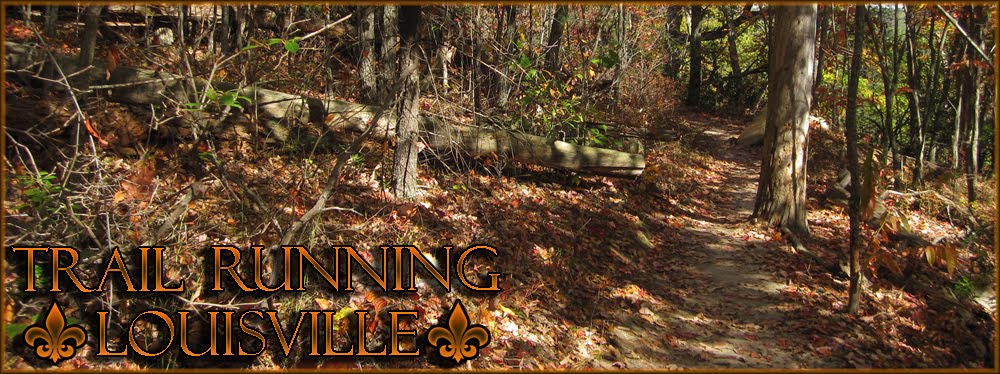Distance: 2.0 miles
Difficulty: Strenuous
Terrain: Technical--primarily dirt with roots and rocks; creek crossings possible; mostly singletrack
Total Ascent: 1187 feet
Total Descent: 1189 feet
Features: Ridgetop hiking with scenic views; views of Louisville; seasonal wildflowers; spring and summer offers lots of bird sightings
Trailhead Location: Tom Wallace Recreation Area (Mitchell Hill Road) Get directions to trailhead
Parking: Paved lot; Get directions to parking lot
Bathrooms: Port-a-pot near lower parking lot (~500' from trailhead); facilities near lake (can not guarantee they are open)
More information: Visit the Jefferson Memorial Forest website; be advised that this trail is also open for horseback riding (always yield to horses)
After turning from Mitchell Hill Road into the Tom Wallace Recreation Area, travel about one mile to find the trailhead and parking. The roundabout at the end of the road is the location of the trailhead. While there are no designated parking spaces in this roundabout, parking shouldn't be a problem. If you are concerned, just to the left of this roundabout is a designated parking area with a port-a-pot available.
(This trail is what I call a "lasso-loop trail", because it has a straight section that leads to the loop. This description is based on traveling in a clockwise direction.)
You will enjoy a steady climb from the beginning of the trail, which is packed dirt with an abundance of roots and rocks. About 500 feet from the start, the trail flattens for just a moment before climbing steeply. Be sure to look to your right, as you will see your first overhead view of Tom Wallace Lake.
At 0.2 mile, you will reach the top of the first hill, which provides a first look at the awesome panoramic views this trail offers. Here, you will notice a trail sign indicating the existence of a spur trail to the right. This spur trail will take you east to the lake and will add less than one mile to your run (round-trip).
Continuing along the Purple Heart Trail, you are greeted with a short, flat section before climbing again on very rocky terrain. At .35 mile, you will reach a high, flat section with stunning panoramic views that include the Louisville International Airport (NE). This is a great place to catch your breath or have a quick snack if you've been running for awhile. Pause to appreciate not only the views, but also to enjoy the beautiful sound of the birds chirping.
If what goes up must go down, here is where you can begin a slow descent. Just beyond 0.6 mile, you will arrive at sign T3, and a very short spur trail that runs southwest to intersect the Siltstone Trail. (The intersection of this spur trail and the Siltstone Trail is just over one mile west of the beginning of the Siltstone Trail, at the Welcome Center.) To continue along the Purple Heart Trail, you will travel right and begin heading north. This area can be a little wet and muddy at times.
At 0.75 mile, you will be at the highest elevation along the Purple Heart (850'). Running the ridge here is more enjoyable because it is less strenuous and you'll have more great views of the airport to distract you. After about one-tenth of a mile, you'll take a left around the bend and begin a general descent for the next half-mile or so. Few obstacles present themselves here, though you will still need to be focused and watch your step.
At 1.1 miles, the descent becomes steeper with more turns and very uneven terrain--be advised that you might be more comfortable hiking this portion if you are not an experienced trail runner. It can also be very slippery when wet.
At 0.75 mile, you will be at the highest elevation along the Purple Heart (850'). Running the ridge here is more enjoyable because it is less strenuous and you'll have more great views of the airport to distract you. After about one-tenth of a mile, you'll take a left around the bend and begin a general descent for the next half-mile or so. Few obstacles present themselves here, though you will still need to be focused and watch your step.
At 1.1 miles, the descent becomes steeper with more turns and very uneven terrain--be advised that you might be more comfortable hiking this portion if you are not an experienced trail runner. It can also be very slippery when wet.
Upon descending this ridge, you'll reach flatter terrain and will run almost parallel to the ridge for a short time. At this point, you'll face four possible creek crossings until 1.5 miles. If there has been any recent precipitation, you may find it difficult to avoid getting wet when crossing these areas. In fact, because this is a lower elevation area, the ground in general may be a little wet in some seasons.
At 1.5 miles, you'll be heading east and will have a brief but intense climb for about one-tenth of a mile. At 1.75 miles, sign T6 indicates a spur trail to the left (which is the same short spur trail leading to Tom Wallace Lake as mentioned before); turn right to continue along the Purple Heart Trail. Eventually, you will see Tom Wallace Lake, now to your left. At 1.8 miles, you'll reach yet another trail sign (T2). You can turn right to re-do the loop, or turn left return to the parking area and Tom Wallace Lake. Enjoy the fruits of your labor on this descent, but watch your footing. It is much more tricky going down than it was going up.
This is a beautiful, but technical trail. Even when it's not wet, the dirt and rocks can be a little loose. Take careful, deliberate steps and always survey the ground several feet in front of you as you run.
Run strong, be smart,
find peace!





